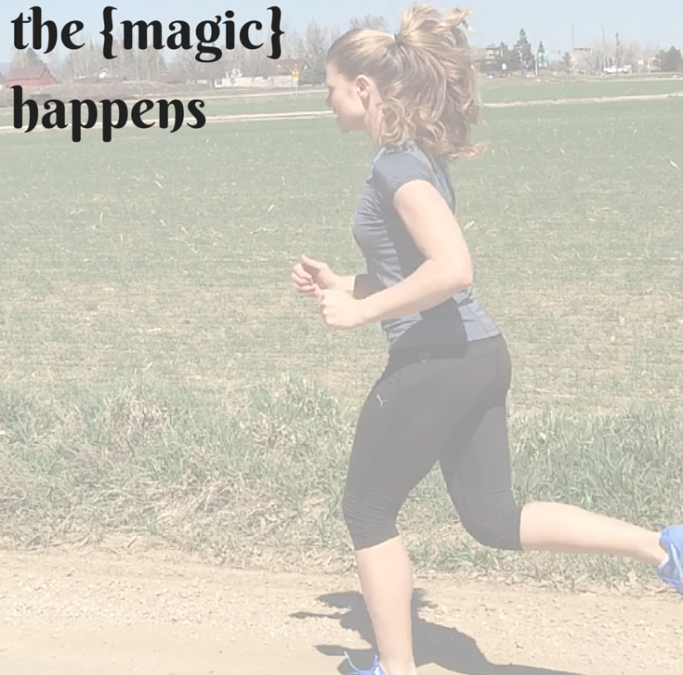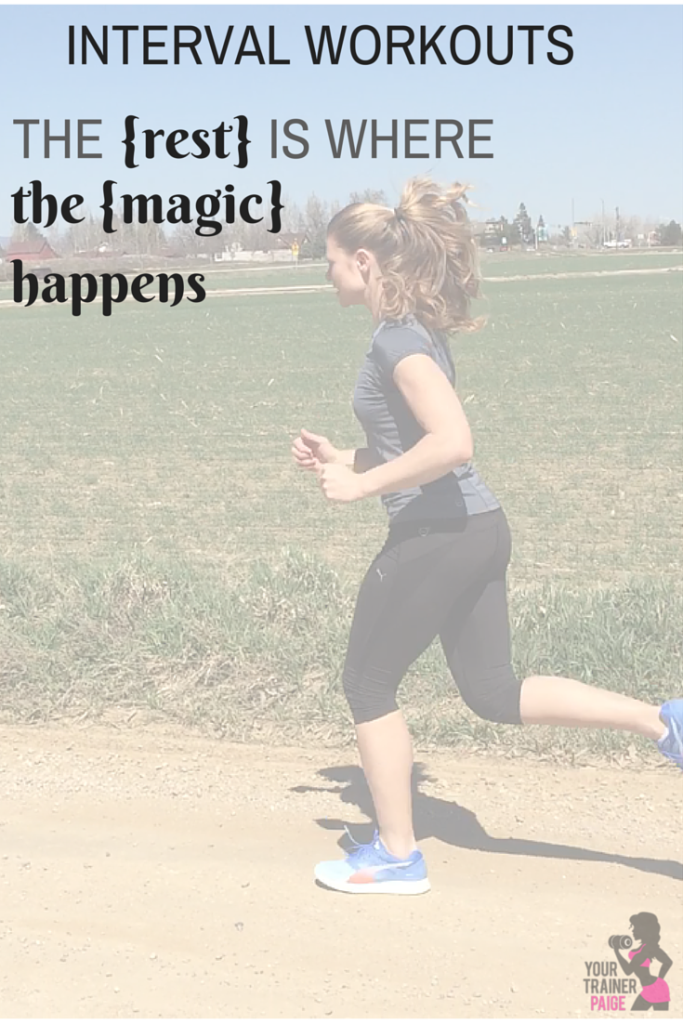Some thoughts and discussions from me.
Good morning, loves! How are ya today? Thanks so much for your discussion on the last couple of days’ posts 🙂
Today we’re changing gears and bringing it back around to fitness. Specifically, let’s talk about interval workouts!
Interval workouts (especially HIIT) have gained extreme popularity over the last few years, which is great because including interval work allows you to get a great cardio benefit in a shorter amount of time.
Today I want to talk about the importance of that ‘rest’ portion of the interval workout, but first, let’s cover some interval workout basics.
There are TONS of ways you can do an interval workout, but at the core of it, the basic premise is that you’re working for a period of time, followed by a period of rest. How they’re set up is typically determined by one of three factors:
3 Ways to Set Up an Interval Workout
1. Time-based.
This means you’ll be working for a determined amount of time, say, :30, followed by a certain time period of rest.
2. Heart Rate-based.
HR intervals are where you’re working in a certain HR zone. When the HR exceeds that zone, you rest until it reaches a new, lower HR zone.
3. Rest-based.
This is the most intuitive form of intervals, and simply means that you work until you can’t, and then rest until you can again.
[Tweet “3 Ways to Set Up an Interval Workout -via @TrainerPaige”]
Benefits of Interval Workouts
Interval workouts are a great way to burn a lot of calories in a short amount of time. They also produce a very high Excess Post Oxygen Consumption (EPOC – aka you’re still burning more calories after your workout’s done.) Most importantly, they’re very effective at improving cardio strength, because hey, the heart’s a muscle, too!
But here’s the thing —
While interval workouts are very popular now, their popularity has also garnered a lot of confusion about how those intervals should be done.
Unless you’re a beginner exerciser looking to build endurance, your work portion of the interval should be done with enough intensity so you feel like you need to rest by the time to rest interval comes around. If you feel like you could keep going, or if it feels easy, you can work harder during those intervals.
That said, you should also feel like you need the complete rest period if you’re doing timed intervals. That’s why I always say the hardest interval workouts are those that have double the amount of rest time as they do work time. That means you’re working SO hard that you need twice as much (or more!) time to recover as you were working. That’s some hard work!
[Tweet “The Rest is Where the Magic Happens – via @TrainerPaige #fitfluential”]
The Rest is Where the Magic Happens
What happens during those rest periods? And why do we need a certain amount of time to feel like we can ‘go’ again?
Well, quite a bit, actually. Our central nervous system recovers, our fast twitch muscle fibers repair, but primarily, once we reach the end of a very intense work interval, we’ve reached or passed our lactate threshold. This means that we’re working so hard that we can no longer efficiently deliver oxygen to the working muscles. You may have heard the term anaerobic before. This literally means ‘without air.’ It’s impossible for our body to work anaerobically for more than a few seconds.
When we’re working anaerobically, we use up ATP – the fuel used during aerobically – while we’re performing these powerful, intense bouts very quickly before creatine phosphate is needed, which is also available for only a short period of time. This means our rest needs to be longer in order to re-build that fuel.
Rest can also be a very strong indicator of progress! Once you regularly add intervals into your routine, you’ll notice that you’ll need less and less rest while working at the same intensity. This means it’s either time to bump up the intensity – or shorten the rest interval!
Make sure you tune in next week for part 2! The right interval workout for your goals – and 3 sample interval workouts
[Tweet “Interval Workouts: The REST is Where the Magic Happens! via @TrainerPaige”]
*My general recommendation is to add HIIT 0-3 times per week depending on your health. Also mix up your intervals so that every time you do them, you’re not pushing it to your max.
How often do you incorporate interval workouts into your routine?
Of possible interest:
Twitter: @TrainerPaige
Instagram: @TrainerPaige
Facebook: Your Trainer Paige
Youtube: Your Trainer Paige
Pinterest: TrainerPaige
Periscope: TrainerPaige





excellent information! I finally got brave enough to start hill sprints this summer. I have seen so much change in my body since – lower body fat, improved core and glutes. It’s not easy but it works! I shoot for 3-4 sessions a week right now since I am lifting less and looking for shorter more intense training this summer.
Headed out the door to run up my hill now!
You do a great job of explaining! Thanks!!!
Thanks for this post. I love to do intervals, but my questions is this: If I know from my heart rate monitor that at the highest point of intensity, my heart rate is around 190 bpm, is this too high? A fitness instructor at the gym said that she thought I was pushing myself too hard. But from your definition, I am pushing myself till I can push no more, which is the right way to do high intensity intervals.
Also, if I get my heart rate that high, I may feel able to go for it again at 175 bpm, but I may not be able to push for as long during subsequent intervals, so sometimes I give myself more rest time, never going below 160-165 bpm. Am I pushing hard enough?
Thanks for your input!
Hey Cate! If you reach your max HR, you really won’t be able to work more than a few seconds at that intensity, as that is literally your highest intensity. It’s too high for doing every day, as your heart needs a break, too. It’d be kind of like, squatting you 1 rep max every day.
If you’re doing 1 minute intervals, it’s likely that your heart rate wouldn’t reach its max, because it’d be impossible to hold that for :60. So, the longer the interval, the lesser the intensity. Does that make sense?
My general recommendation is 0-3 times a week for HIIT.
Love your blog – you’ve always got a lot of helpful information and great, actionable tips.
Normally I wouldn’t say anything, because I agree with all of the conclusions you’re drawing, and none of this really matters for purpose of acting on what you’re saying. But, 1) I’m the type of person who can have a better workout experience if I understand what’s going on inside my body, so I wanted to put this out there for anyone like me; and 2) I’m taking the ACE GFI certification exam tomorrow morning, so it’s fresh in my mind, and I thought this would be a good exercise for me as I’m studying today. So, I’m gonna be “that guy” for a second and do the whole, “Technically…” thing, lol.
In your last few paragraphs, I think you’re confusing the anaerobic production of ATP with the phosphagen system. As I understand it, we don’t use up ATP when we work anaerobically; ATP is constantly being produced as needed, with or without oxygen. If ATP isn’t available, the muscle can’t contract. During anaerobic exercise, lactic acid is produced faster than the bloodstream can filter it, so it begins to build up within your muscles. Eventually, you reach the lactate threshold, which causes a burning sensation, followed by muscle fatigue and a need to cease activity. This takes anyway from 1-3 minutes. You’re still able to produce ATP, but the pH imbalance caused by lactate disrupts activity.
The phosphagen system, on the other hand, is the brief store of ATP that your body uses when you initiate activity. Your body takes a moment to respond to the increased need for ATP production, so it relies on phosphagen reserves at the onset. (Interestingly, this also allows for the “fight or flight” response in an emergency.) As the phosphagen system is just meant to bridge the gap, it can only last for about 10 seconds of all-out exertion. After it’s gone, the body switches to the anaerobic production of ATP (which, by this point, has responded).
In context of HIIT: you use your phosphagen reserves at the start of an interval; then, you switch to anaerobic ATP production, and lactate begins to build up; then, you reach your lactate threshold, during which time you either cease activity or (if your interval time isn’t up yet) rapidly lose intensity. During the break (when the magic happens, as you say), your phosphagens replenish themselves to prepare for the onset of the next interval, and your bloodstream carries away lactic acid to restore your pH balance. If either of these systems isn’t given enough time to recover, you’ll fatigue faster, and your next interval will either be shorter, or less intense and sloppier. If, on the other hand, your rest periods are long enough, you can sustain HIIT for a ridiculous amount of time.
That having been said, I’m a huge fan of HIIT, and a big believer in having an adequate rest time. A few months ago, I came across a study that compared High-Intensity Intermittent Exercise with aerobic activity, and their effects on body fat and composition. Lot of interesting results. Blew away a lot of common misconceptions I believed about losing weight (the old “cardio for fat burn” myth). You can find it here, if you’re interested: http://www.ncbi.nlm.nih.gov/pmc/articles/PMC2991639/ Anyway, I’m super excited to read part 2! I look forward to seeing what kind of suggestions you have for switching up your HIIT for different goals. I have so much more to learn about HIIT – it’s such a deep and fascinating subject! Thanks for tackling this topic!
By the way, I hope I wasn’t too much of a jerk – I know nobody likes being called out, and I really debated about saying anything. For what it’s worth, writing the above comment helped me organize some really fragmented thoughts about ATP production, and I feel ridiculously ready to answer any test questions about it; where before I felt like I had a somewhat tenuous grasp on the concept. So, I hope you don’t mind, because this was a great study tool for me, lol. Anyway, thanks!
Not at all! 🙂
Doh! You’re completely right – total brain fart on my part. Fixing now! ATP is used aerobically, and it’s actually creatine phosphate that’s used anaerobically. However, we don’t have unlimited sources of ATP, and we do use ATP while working anaerobically – but only up to 5 or so seconds before creatine phosphate kicks. In . Thanks for the in depth comment, and for calling me out 😉
After doing lots of running the past week, because I was away, I am looking forward to adding some interval training in, to change things up a bit. I am looking forward to it. 🙂